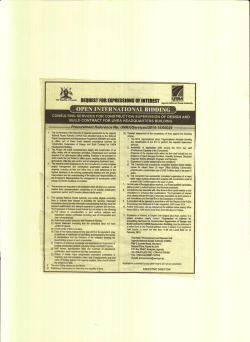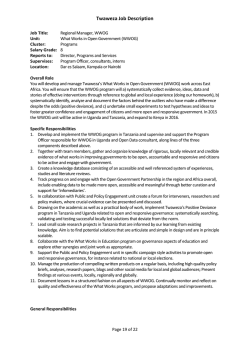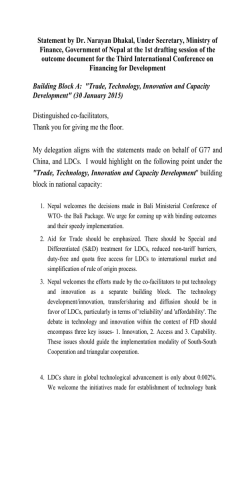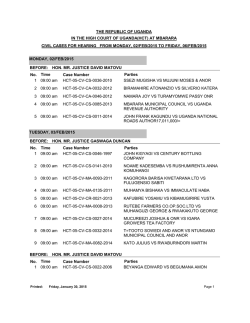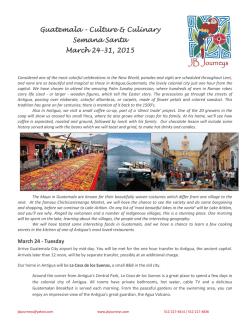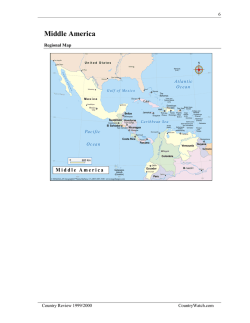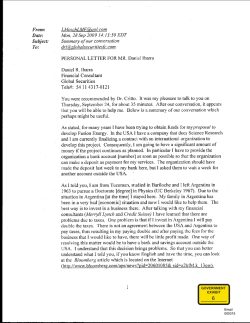
letter - AIDS Healthcare Foundation
World Bank, $2.86 per day is not a Middle Income wage! International appeal of NGOs calling on the World Bank to revise the Middle Income Country designation criteria August 13, 2015 Dr. Jim Yong Kim, President The World Bank 1818 H Street, NW Washington, DC 20433 Re: The impact of the World Bank reclassification on the Middle Income Countries Dear Dr. Kim, The World Bank has reclassified 28 countries from Low- to Middle-Income Countries (MIC) since the year 2000.1 These countries deserve praise for their economic growth, but the World Bank income classification scale sends a global message that is distorting the reality and does not accurately reflect the income level of the majority of people in these countries. As a consequence of the MIC status, states with weak economies are now facing reductions in foreign aid, fewer concessionary development loans and higher prices for essential medicines, such as the antiretroviral therapy for HIV. The common interpretation of the “Middle Income” classification is that people in this bracket should have sufficient income to satisfy the basic necessities of life such as adequate housing, food, clothing and access to health care. In reality, 75% of the world’s poor now live in the MICs.2 Therefore, we are convinced that the scale is broken and needs to be adjusted. For political reasons, some governments of developing countries prefer to be placed in higher economic classifications by the World Bank, but in addition to the aspirations of the governments, the classification should take into account the often-poor living conditions that remain in place for the majority of the populations after the change in country classification. There is an inherent disconnect between the implied meaning of the MIC label as “not poor” and the purchasing power of the people in them. The middle-income bracket encompasses countries with the Gross National Income per capita of $1,045 to $12,736, which is approximately equivalent to a daily income of $2.86 to $34.89. This puts China and Kenya in the same income group. How could a person be considered to be living above the subsistence level when the lower end of the MIC bracket is only $1.61 higher than the International Poverty Line of $1.25 per day? In a recent article, Médecins Sans Frontières aptly noted that, “The term ‘middle-income’ is an artificial classification that is not linked to public health realities on the ground.”3 The World Bank income classification is being applied by the pharmaceutical companies to set tiered pricing on medicines that makes them much more costly for the MICs. For example, Atripla a brand-name version of a commonly prescribed first-line HIV treatment regimen is accessible to the Low-Income Countries at the base cost of $613 per patient per year (ppy), while the same drug costs MICs at least $1033 ppy, although many countries such as Mexico, Viet Nam and Ukraine pay double of that or more.4 The donors are increasingly using the MIC label to justify funding cutbacks and decrease the pool of countries eligible for the development assistance. For example, the Global Fund to Fight AIDS, Tuberculosis and Malaria sets proportionately lower ceilings on funding levels for bands of countries based on their income classification. As a result, the MICs now have the largest proportion of the global HIV burden but are facing the prospect of fighting the epidemic with less money. 1 http://www.theguardian.com/global-development/poverty-matters/2011/jul/12/world-bank-reclassifies-28-poor-countries http://www.msfaccess.org/sites/default/files/MSF_UTW_17th_Edition_4_b.pdf http://infojustice.org/archives/34723 4 http://www.msfaccess.org/content/untangling-web-antiretroviral-price-reductions-17th-edition-%E2%80%93-july-2014 2 3 1 This problem is especially acute in Sub-Saharan Africa as Figure 1 demonstrates below. Of the 10 countries with the highest HIV prevalence in the world, which are all located in Sub-Saharan Africa, seven are considered MICs. The majority of Africa’s people living with HIV now reside in countries that are no longer considered poor according to the World Bank scale. Developed by AHF, source data from UNAIDS and the World Bank. South Africa and Lesotho, for example, are considered Upper and Lower Middle-Income Countries respectively, even though South Africa’s GNI per capita is five times greater than that of Lesotho. With equally enormous burdens of HIV in both countries, on average a resident of Lesotho has to survive on $3.69 per day, compared to a South African with $18.60 per day. Given the disparity between these countries, it is clear that the lower limit of the Middle-Income bracket is too low. In the discussion on the income group classification methodology, the World Bank concedes that the Low- and Middle-Income labels “[do] not imply that economies in the same income group have reached similar stages of development or that high-income economies have reached a preferred or final stage of development.”5 It also points 5 http://data.worldbank.org/news/2010-GNI-income-classifications 2 out that GNI per capita is an imperfect benchmark because it tends to ignore inequalities in income distribution, which coincidentally are greatest in Sub-Saharan Africa. However, in the context of global development, and specifically public health financing these important limitations are being overlooked to the detriment of millions of poor people, who aren’t any better off financially but now find themselves living in the MICs. We urge you as the head of the World Bank to undertake the revision of the income classification methodology so that it is more closely aligned with the economic realities of the people in the developing world. The perceived meaning of the MIC label needs to correspond to an income threshold that is sufficiently high to meet a person’s basic necessities and put him or her firmly above the poverty line. Specifically, we propose to set the lower limit of the MIC category at, or above $3650 of GNI per capita – equivalent to $10 day. The mission of the World Bank is to end extreme poverty within a generation and boost shared prosperity. This goal cannot be accomplished by renaming developing countries into MICs; the underlying problems associate with global poverty will remain in place until we face up to reality and start calling things for what they are. We respectfully request a meeting between the representatives of the NGO coalition supporting this appeal, you and the World Bank leadership, to further discuss possible solutions to the challenges outlined in this letter regarding the country income classification scale. Sincerely, the undersigned organizations: 1 2 3 4 5 6 7 8 9 10 11 12 13 14 15 16 17 18 19 NGO Name Country AIDS Healthcare Foundation - Coalition Coordinating Body International Association of Providers of AIDS Care (IAPAC) United States United States Africa Citizen’s Health Education and Development Initiative (CHEDI) Community Health Focus (CHeF) Network of People Living With HIV/AIDS in Nigeria (NEPWHAN) OROL Youth Empowerment Initiative (OROL) PLAN Foundation ProjektHope Nigeria (Curator of http://www.nigeriahivinfo.com) The Association Of Religious Leaders Living With/Personally Affected By HIV/AIDS in Nigeria (NINERELA+) Treatment Access Mobilizers Initiative (TAM) formerly Treatment Action Movement Women Initiative For Family Empowerment (WIFE) Action Aid Uganda Center for Participatory research and Development (CEPARD) Coalition for Health Promotion and Social development Community Health Alliance Uganda Health Journalists’ Network in Uganda (HEJNU) Home Based Care Alliance, Kawempe - Uganda Ice Breakers Lungujja Community Health Caring Organization (LUCOHECO) Mama’s Club Nakawa Home Base Care Givers Alliance Nigeria Nigeria Nigeria Nigeria Nigeria Nigeria Nigeria Nigeria Nigeria Uganda Uganda Uganda Uganda Uganda Uganda Uganda Uganda Uganda Uganda 3 20 21 22 23 24 25 26 27 28 29 30 31 32 33 34 35 36 37 38 39 40 41 42 43 44 45 46 47 48 49 50 51 52 53 54 55 56 57 58 59 60 National Community of Women Living with HIV/AIDS in Uganda (NACWOLA) Positive Men’s Union (POMU) Public Health Ambassadors Uganda (PHAU) Sexual Minorities Uganda (SMUG) Support The Children (SUTCHI) Uganda Network of AIDS Service Organizations Hope for Africa International MWAROKY HIV/AIDS SAVERS Latin America and Caribbean Adolescentes contra el Sida (ACES) Jesús María Amigos en Salud, Rosario Asociación de Trans y Trabajadorxs Sexuales (ATTS), Río Negro Asociación Mutual Hughes F.B.C. Asociación Portadores de Vida, Formosa Fundación Bienestar, Venado Tuerto Prevensida, Venado Tuerto Red Argentina de Mujeres con VIH Red Bonaerense de PVVS, Buenos Aires Red de Adultxs Positivxs +30 (RAP+30) Red Diversa Positiva Nacional Sociedad Argentina Interdisciplinaria de Sida (SAISIDA) Acción Para Una Vida Saludable O.N.G. Asociación Apevihs Asociación Artística Kakol Kiej Asociación De Jóvenes Diversos En Acción (Somos) Asociación De Promotores De Salud Villa Del Quetzal San Juan Sacatepequez Asociación De Salud Integral (Asi) Asociación Gente Nueva Asociación Investigacion, Desarrollo Y Salud Integral (Idei) Asociación Iseri Ibagari Coalición Internacional de Preparación para el Tratamiento (ITPC-Latca) Comisión Episcopal De Justicia Y Solidaridad Subcomisión De Vih Conferencia Episcopal De Guatemala Foro Permanente Ciudadano Por La Salud De Los Pueblos Frente Nacional De Lucha Por La Defensa De Los Servicios Públicos Y Recursos Naturales (FNL) Fundación Esfuerzos Y Prosperidad (Fundaespro) Fundación Fernando Iturbide ITPC Latin America and The Caribbean Sindicato Nacional De Trabajadores De La Salud De Guatemala (S.N.T.S.G) EVE for Life Jamaica Aids Support for Life Jamaica Family Planning Association Women’s Resource and Outreach Center Uganda Uganda Uganda Uganda Uganda Uganda Zambia Zambia Argentina Argentina Argentina Argentina Argentina Argentina Argentina Argentina Argentina Argentina Argentina Argentina Guatemala Guatemala Guatemala Guatemala Guatemala Guatemala Guatemala Guatemala Guatemala Guatemala Guatemala Guatemala Guatemala Guatemala Guatemala Guatemala Guatemala Jamaica Jamaica Jamaica Jamaica 4 61 62 63 64 65 66 67 68 69 70 71 72 73 74 75 76 77 78 Agencia de Noticias Independiente Noti-Calle Brigada Callejera de Apoyo a la Mujer, "Elisa Martínez", A.C. Coalición de Activistas por el Derecho Universal en VIH/Sida Condomóvil AC El Encanto del Condón Red Mexicana de Trabajo Sexual Amigos Unidos del Sur Sin Fronteras (AUDESF) COMSERPAR Comunidad de Mujeres Positivas Perú CONVIHVIR Coordinadora Nacional de Peruanos Positivos INPACVIH Lazos de VIDA Red de comunicación e información para grupos de ayuda muta del Perú (Redecoms) Red de Trabajadoras Sexuales de Latinoamérica y El Caribe (Redtrasex)-Perú Red Sida Perú (13 groups) SIDA VIDA Trabajo Organizado por los Derechos Sexuales (TOD@S) Mexico Mexico Mexico Mexico Mexico Mexico Peru Peru Peru Peru Peru Peru Peru Peru Peru Peru Peru Peru Eastern Europe 79 80 81 82 83 84 85 86 87 88 89 90 91 92 93 94 95 96 97 98 99 100 101 “Patients in Control” initiative Charitable Fund “Humanitarian action” Community advisory board in Eastern Europe and Central Asia (EECA CAB) International Treatment Preparedness Coalition in EECA (ITPCru) Kazan Public Organization “Vera” Open Health Institute, Russia Russian women's network "E.V.A." “Healthcarers” community initiative All-Ukrainian Network of PLWH East Europe and Central Asia Union of PLWH (ECUO) Russia Russia Russia Russia Russia Russia Russia Ukraine Ukraine Ukraine Asia Cambodian People living with HIV Network (CPN+) Cooperation for Social Services and Development (CSSD) Health and Development Alliance (HEAD) Cambodia KHEMARA Men's Health Social Service (MHSS) Women Organization for Modern Economy and Nursing Beijing Gender Health Education Institute Beijing Jing Jing Concentric Volunteers Development Center Beijing LGBT Center Beijing LGBT Mental Health Center China Rainbow Health Organization Hold Your Hands for Tomorrow LGBT Community Service Center Cambodia Cambodia Cambodia Cambodia Cambodia Cambodia China China China China China China China 5 102 103 104 105 106 107 108 109 110 111 112 113 114 115 116 117 118 119 120 121 122 123 124 125 126 127 128 129 130 131 132 133 Ren’ai Community Weifang concentric along consulting service center Bharosha seva samite khairhan Dharti Gramothan Evam Sahabhagi Gramin Vikas Samiti Humana People to People India Jyothis Charitable Trust Maitri India Network for People Living with HIV in Maharashtra NPM+ Saathi Care Home Smt. Susheel Gyan Siksha Prachar-Prassar Samitee Social Welfare Institute (Caritas) Society for Participatory Integrated Development Sun Shine Health and Social Welfare Society Swargiya Kanhai Shukla Samajik Sewa Sansthan (SKSSSS) Astha Samuha Chhahari Mahila Samuha (CMS) Community Support Group (CSG) Dharan Positive Dristi Nepal Jagriti Mahila Maha Sangh Junkiree, Banke Lumbini Plus (LP) National Association of PLHA in Nepal (NAP+N) Saarathi Nepal Sakriya Plus Nepal Sneha Samaj SPARSHA Nepal Syangja Support Group (SSG) Trisuli Plus (TP) Union C Youth Vision Medical Committee Netherland - Vietnam China China India India India India India India India India India India India India Nepal Nepal Nepal Nepal Nepal Nepal Nepal Nepal Nepal Nepal Nepal Nepal Nepal Nepal Nepal Nepal Nepal Vietnam Correspondence is response to this letter may be sent to: NGO Coalition on the World Bank MIC Classification 6660 Santa Monica Blvd. 2nd Floor Los Angeles, CA 90038 United States of America [email protected] 6
© Copyright 2026
